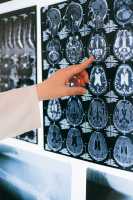 MedicalResearch.com Interview with:
Timothy R. Smith, M.D., Ph.D., M.P.H
MedicalResearch.com Interview with:
Timothy R. Smith, M.D., Ph.D., M.P.H.
Pituitary/Neuroendoscopy Fellow
Department of Neurosurgery
Brigham & Womens Hospital
Harvard University Boston, MA 0211
Medical Research: What is the background for this study? What are the main findings?
Dr. Smith: Defensive medicine is the practice of prescribing unnecessary medical treatment for fear of being sued – it is widely practiced in the United States and contributes to our rising healthcare costs. In high-risk specialties such as neurosurgery, the fear of litigation leads to defensive practices that actually impact clinical decisions. A 2009 American College of Emergency Physicians report created malpractice risk profiles for each state based on its legal atmosphere, tort reform, and insurance availability. Based on these profiles, each state was ranked from 1 to 50 and sorted into separate categories, ranging from A, for the best liability environment, to F, for the worst. We sent a 51-question, anonymous online survey, which covered topics ranging from patient characteristics to surgeon liability profiles, to board-certified US neurosurgeons in the American Association of Neurological Surgeons. The purpose was to determine how neurosurgeons’ perceptions of their medico-legal environments correlated with these established state risk profiles, as well as whether each state’s liability risk environment was a predictor of defensive medical practices.
We found that though the average malpractice insurance premium was $103,000 per year, neurosurgeons from high-risk states paid significantly more ($128,000) than those from low-risk states did ($75,000). Even with these amounts, almost 70% of respondents felt that their insurance coverage was inadequate, and 90% felt that the insurance premium was a financial burden. Neurosurgeons from high-risk states were also twice as likely to have been sued as those from low-risk states were. More than 80% of respondents ordered additional imaging for defensive medical purposes, and more than 75% said they ordered additional laboratory tests and made unnecessary referrals for defensive purposes; this behavior was more prevalent in high-risk states. After controlling for important confounders, we found that for every letter-grade change from “A” to “F”, neurosurgeons are 1.5 times more likely to engage in defensive behaviors. For example, moving from a “D” state to an “A” state represents 4.5 fold difference in defensive behaviors.
(more…)
 While anterior cervical discectomy surgery has become a widely accepted and frequently performed procedure to relieve spinal cord or nerve root compression, it is not without potential risks and complications. These can range from common surgical risks, such as infection, to more procedure-specific complications like nerve damage, dural tears, and the possibility of recurrent disc herniation. As there is a critical need for increased awareness and understanding of these challenges, it is essential to engage in a thorough exploration of the potential outcomes and their management tactics.
While anterior cervical discectomy surgery has become a widely accepted and frequently performed procedure to relieve spinal cord or nerve root compression, it is not without potential risks and complications. These can range from common surgical risks, such as infection, to more procedure-specific complications like nerve damage, dural tears, and the possibility of recurrent disc herniation. As there is a critical need for increased awareness and understanding of these challenges, it is essential to engage in a thorough exploration of the potential outcomes and their management tactics.


